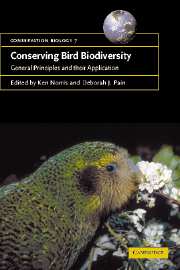Book contents
- Frontmatter
- Contents
- List of contributors
- Preface
- 1 Biodiversity – evolution, species, genes
- 2 Why conserve bird diversity?
- 3 Mapping and monitoring bird populations: their conservation uses
- 4 Priority-setting in species conservation
- 5 Selecting sites for conservation
- 6 Critically endangered bird populations and their management
- 7 Diagnosing causes of population declines and selecting remedial actions
- 8 Outside the reserve: pandemic threats to bird biodiversity
- 9 Predicting the impact of environmental change
- 10 Fragmentation, habitat loss and landscape management
- 11 The interface between research, education and training
- 12 Conservation policies and programmes affecting birds
- References
- Index
3 - Mapping and monitoring bird populations: their conservation uses
Published online by Cambridge University Press: 10 December 2009
- Frontmatter
- Contents
- List of contributors
- Preface
- 1 Biodiversity – evolution, species, genes
- 2 Why conserve bird diversity?
- 3 Mapping and monitoring bird populations: their conservation uses
- 4 Priority-setting in species conservation
- 5 Selecting sites for conservation
- 6 Critically endangered bird populations and their management
- 7 Diagnosing causes of population declines and selecting remedial actions
- 8 Outside the reserve: pandemic threats to bird biodiversity
- 9 Predicting the impact of environmental change
- 10 Fragmentation, habitat loss and landscape management
- 11 The interface between research, education and training
- 12 Conservation policies and programmes affecting birds
- References
- Index
Summary
INTRODUCTION
Accurate and up-to-date distribution maps and a good numerical insight into population sizes and trends are a prerequisite for effective conservation. The conservation status of a species hinges on three questions: ‘Where are they?’, ‘How many are there?’ and ‘What is their trend?’ This chapter focuses on providing answers to these questions. We cannot conserve what we do not understand.
This chapter provides a series of examples and case studies into conservation applications of bird inventories and bird monitoring. However, even the best inventories and perfect monitoring make no contribution to conservation on their own. This information simply allows an assessment of the status of a species or a site: it will not, for example, halt a species' decline. Explanations need to be found for trends, and management and action plans need to be compiled and implemented. Monitoring needs to be built into these actions, otherwise we have no measure of the impact of conservation interventions.
One of the most outstanding conservation successes of the twentieth century – the widespread removal of organochlorine insecticides from the environment – showed clearly the role that monitoring plays in bird conservation. These harmful chemicals caused direct mortality of adult birds of prey, most notably peregrines (Falco peregrinus), through accumulation in body tissues, and caused indirect mortality through thinning of their eggshells leading to reduced hatching success and poorer breeding performance. Consequently, peregrine populations declined worldwide, and only recovered when organochlorine usage was reduced.
- Type
- Chapter
- Information
- Conserving Bird BiodiversityGeneral Principles and their Application, pp. 34 - 60Publisher: Cambridge University PressPrint publication year: 2002
- 12
- Cited by

